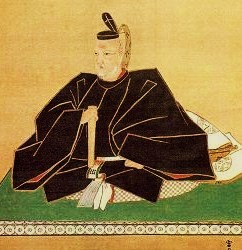Hoshina Masayuki
| Hoshina Masayuki | |
|---|---|
 |
|
| Lord of Aizu | |
|
In office 1643–1669 |
|
| Preceded by | None |
| Succeeded by | Hoshina Masatsune |
| Personal details | |
| Born |
June 17, 1611 Edo, Japan |
| Died | February 4, 1673 (aged 61) |
| Nationality | Japanese |
| Relations |
Father: Tokugawa Hidetada Mother: Oshizu no Kata |
Hoshina Masayuki (保科 正之?, June 17, 1611 – February 4, 1673) was a Japanese daimyō of the early Edo period, who was the founder of what became the Matsudaira house of Aizu. He was an important figure in the politics and philosophy of the early Tokugawa shogunate.
Hoshina Masayuki was born in Edo, the illegitimate son of the 2nd shogun, Tokugawa Hidetada. As Masayuki's mother, Oshizu no Kata (1584–1635, later called Jōkō-in) was a servant, Hidetada chose to hide the newborn, then named Yukimatsu. This was to protect him from potential infanticide at the hands of Oeyo, Hidetada's wife. Yukimatsu was later secretly given in adoption to Hoshina Masamitsu, a former Takeda retainer, and lord of the Takatō Domain. In 1631, Yukimatsu inherited the Hoshina family headship, as well as the Takatō fief, and changed his name to Masayuki. Later recognized by his father and by his brother, the third shogun Iemitsu, he was able to wield great influence in political affairs, and was to consequently see his income rating rise sharply. Masayuki became lord of the Yamagata Domain and was then moved to the Aizu domain (Mutsu Province, 230,000 koku), and founded the Aizu-Hoshina line (known from his son's generation onward as the Aizu-Matsudaira) which was to remain enfeoffed there until the Boshin War.
Masayuki received great political clout with his rise in income, appointment as one of the shogun's advisors, and regent during the minority of his nephew, the 4th shogun Tokugawa Ietsuna. However, when offered the use of the Tokugawa crest, and the Matsudaira surname, he declined, out of respect to the Hoshina family and its retainers. The crest and surname were adopted during the lordship of his son Masakata.
...
Wikipedia
